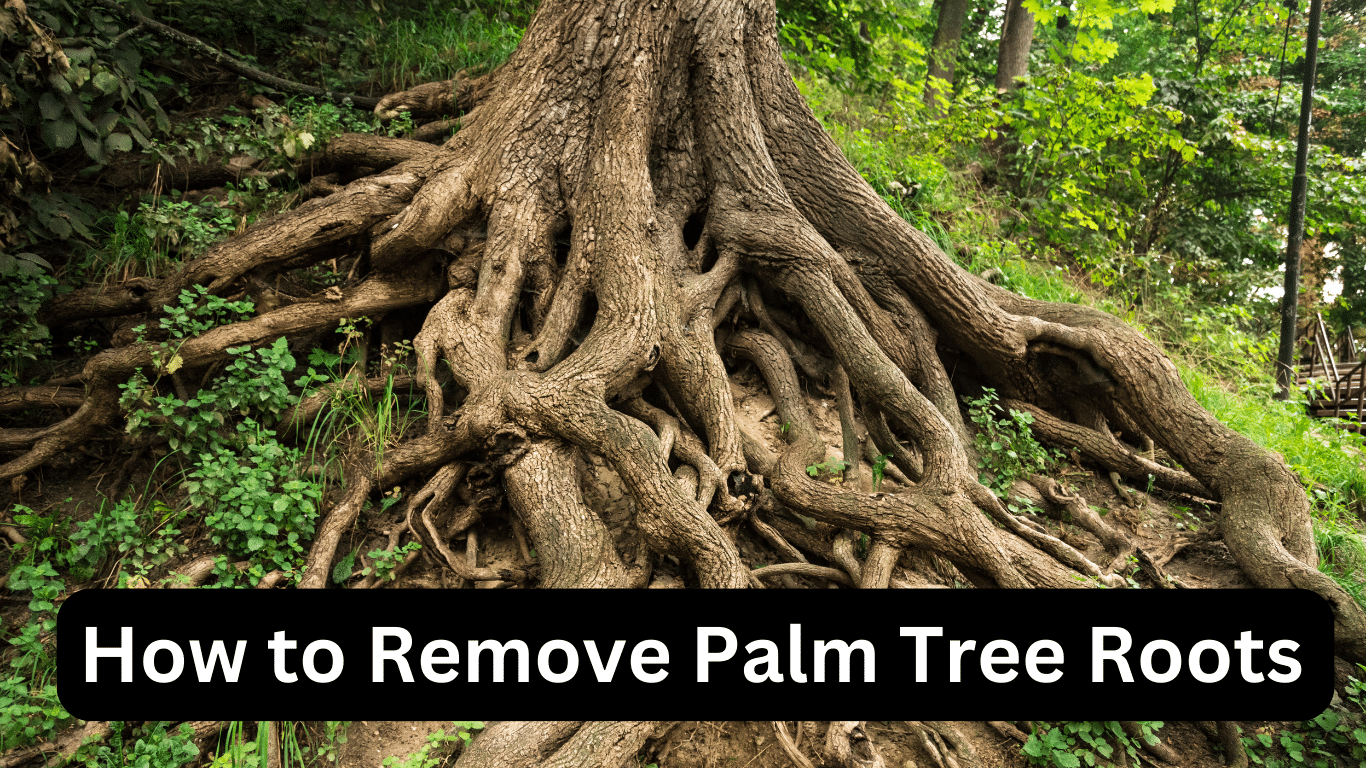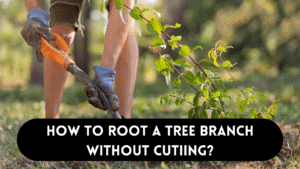Having a beautiful and well-maintained yard is a dream for many homeowners. However, the presence of palm tree roots can often become a nuisance and hinder the aesthetics of your landscape. In this guide, we’ll explore some efficient methods to remove palm tree roots safely and effectively, ensuring your yard remains pristine. Remember, it’s best to seek professional assistance if you need clarification on any of these methods.
Mehods to Remove Palm Tree Roots
Splitting the Root into Sections:
When dealing with thick and stubborn palm tree roots, splitting them into smaller sections can make the removal process much easier. Here’s how you can do it:
- First, carefully locate the troublesome root by digging around the tree’s base.
- Once you’ve exposed the root, cut it into manageable pieces with a saw or an axe.
- Be cautious during this process to avoid damaging the tree or injuring yourself.
- This method allows you to remove the root gradually, tackling the problem step by step.
Digging Around Surface Roots
Palm tree roots tend to grow laterally and spread deep into the soil. It’s best to start by focusing on the surface roots to handle this. Here’s what you should do:
- Begin by gently digging around the surface roots, mindful not to disturb the tree’s stability.
- As you dig, you’ll expose larger roots that are easier to remove than those buried deep.
- Carefully clear the soil around the roots until you can access the main root system.
- This method is suitable for smaller trees or those with shallow root systems.
Using a Stump Grinder
A stump grinder is one of the most effective tools for complete palm tree stump and root removal. Here’s how you can use it:
- Rent or purchase a stump grinder from a garden supply store or equipment rental facility.
- Position the grinder over the stump and start grinding, allowing it to break the stump and roots into smaller pieces.
- Follow safety guidelines and wear appropriate protective gear while using the grinder.
- Once the stump and roots are in smaller fragments, removing them from the ground becomes much easier.
Using Horticultural Vinegar
To prevent new sprouts from emerging from the palm tree stump’s root system, horticultural vinegar can be an effective solution:
- Apply horticultural vinegar to the areas where new sprouts are appearing.
- The vinegar’s high acidity helps to kill unwanted growth without causing harm to the surrounding soil.
- This environmentally friendly method makes it a suitable option for eco-conscious gardeners.
- Remember that vinegar may take some time to eradicate the sprouts.
Chemical Treatment
Using chemicals to remove palm tree roots can be a more aggressive approach. Here’s how you can do it:
- Drill several holes into the palm tree stump, ensuring they are about 8 inches deep.
- Pour the appropriate root-killing chemical into the holes and let it take effect.
- Chemical treatments can be potent, so follow the instructions carefully and take safety precautions.
- After the roots have died, removing them from the ground becomes less challenging.
Manual Removal
For a hands-on approach, manual removal involves a more physical effort. Here’s how you can go about it:
- Dig around the palm tree stump and cut off any visible roots.
- Gradually remove the soil until the entire root ball is exposed.
- By thoroughly exposing the root system, you can carefully remove it from the ground.
- This method may require more time and effort but ensures complete removal.
Frequently Asked Questions
What tools are needed to remove palm tree roots?
Removing palm tree roots requires the right tools to ensure the process is efficient and safe. Here are some essential tools you’ll need:
Shovel: A sturdy shovel is necessary for digging around the root system and exposing the roots for removal.
Axe or Saw: To cut through thicker roots or split them into smaller sections, an axe or saw will come in handy.
Stump Grinder: A stump grinder is the most effective tool for completely removing the stump and roots.
Horticultural Vinegar or Root-Killing Chemicals: If you want to prevent new sprouts from growing, horticultural vinegar or root-killing chemicals can be useful.
Safety Gear: Remember to wear safety gear such as gloves, eye protection, and sturdy footwear to protect yourself during removal.
Measuring Tape: This can be useful for assessing the root system’s size and planning the removal strategy.
These tools will make the palm tree root removal process much more manageable and ensure a successful outcome.
How long does it take to remove palm tree roots?
The time it takes to remove palm tree roots can vary depending on several factors:
Size of the Tree: Larger palm trees generally have more extensive root systems, which will take longer to remove.
Root System Complexity: The layout and complexity of the root system can impact the time needed for removal. Deeply rooted or tangled roots require extra effort.
Chosen Removal Method: Different removal methods have varying time requirements. Manual removal can take longer than using a stump grinder, for example.
Experience and Tools: Your experience with the task and the availability of suitable tools will also influence the duration.
Removing palm tree roots can take several hours to a full day, and sometimes even longer for more challenging cases. Being patient and taking the time needed to ensure the job is done correctly is essential.
What are some safety precautions when removing palm tree roots?
Ensuring safety during palm tree root removal is crucial to prevent accidents and injuries. Here are some important safety precautions to follow:
Wear Protective Gear: Always wear safety gloves, eye protection, and sturdy footwear to shield yourself from potential hazards.
Inspect the Area: Before starting, inspect the area around the tree for any potential obstacles or underground utilities that could interfere with the removal process.
Proper Tool Use: Use tools as intended and handle them carefully to avoid accidents. Keep sharp objects away from others and yourself.
Secure the Tree: If the tree is unstable, consider bracing or cabling it to prevent it from falling unexpectedly.
Working with Others: Have someone nearby while you work if you need assistance.
Keep Children and Pets Away: Ensure that children and pets are at a safe distance during the removal process.
Adhering to these safety precautions can significantly reduce the risk of accidents and injuries while removing palm tree roots.
What is the easiest way to remove a palm tree?
Removing a palm tree can be a challenging task, but here’s an easier approach you can take:
Professional Tree Removal: Hiring a professional tree removal service is the easiest way to ensure safe and efficient palm tree removal.
Consult an Arborist: If you need more clarification about the tree’s condition or the best removal approach, consult an arborist for expert advice.
Permit Check: Check with your local authorities if you need any permits for tree removal to avoid legal issues.
Prepare the Area: Clear the area around the tree to provide ample space for removal.
Cut the Tree: Use appropriate tools or hire professionals to cut down the tree carefully.
Stump Removal: Depending on your preference, you can grind the stump or leave it in place as a garden feature.
By relying on professionals and experts, you can simplify palm tree removal and ensure a hassle-free experience.
Do I need to remove palm tree roots?
Removing palm tree roots is not always necessary, but there are some situations when it’s advisable:
Dead or Dying Trees: If the palm tree is dead or dying, removing the roots can prevent disease spread and free up space for new plantings.
Root Damage: Removal might be necessary if the palm tree roots are causing structural damage to nearby buildings or pathways.
New Landscaping Plans: When you want to redesign your landscape, removing palm tree roots can create space for new plants or features.
Safety Concerns: Removal is recommended if the roots pose a safety hazard, such as tripping hazards.
Tree Replacement: Removing the roots might be necessary if you plan to replace the palm tree with a different type of tree.
However, leaving the roots in place is acceptable if the palm tree is healthy and not causing any issues.
Conclusion
Removing palm tree roots can be challenging, but with the right methods and precautions, you can achieve a cleaner and more appealing yard. Whether you opt for splitting, grinding, chemical treatment, or manual removal, always prioritize safety and do not harm the tree or yourself. Remember, it’s always wise to seek professional help if you need clarification on handling the job independently. Enjoy your beautiful yard without the hassle of unwanted palm tree roots.




